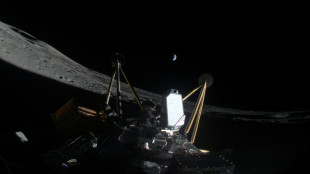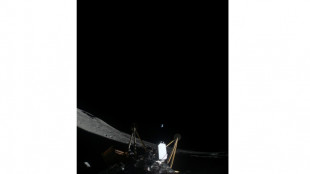
-
 China consumption slump deepens as February prices drop
China consumption slump deepens as February prices drop
-
'Things are different' Djokovic says after another early exit at Indian Wells

-
 Colombian guerillas release hostage security forces
Colombian guerillas release hostage security forces
-
France lose Dupont but Six Nations title on the cards after thrashing Ireland

-
 Phone bans sweep US schools despite skepticism
Phone bans sweep US schools despite skepticism
-
Did Ukraine have to become a partisan US issue?

-
 Djokovic crashes out of Indian Wells opener
Djokovic crashes out of Indian Wells opener
-
Britain's King Charles calls for unity in 'uncertain times'

-
 Morikawa seizes lead at Arnold Palmer after birdie rally
Morikawa seizes lead at Arnold Palmer after birdie rally
-
Alcaraz, Keys breeze into Indian Wells third round

-
 Record-setting Skotheim claims European indoor heptathlon title
Record-setting Skotheim claims European indoor heptathlon title
-
Inter survive Monza scare to extend Serie A lead

-
 Argentina port city 'destroyed' by massive rainstorm, 13 dead
Argentina port city 'destroyed' by massive rainstorm, 13 dead
-
Townsend relishing 'toughest fixture' in France after Scotland's Six Nations win over Wales

-
 Colombian guerillas release hostage security forces: AFP
Colombian guerillas release hostage security forces: AFP
-
Some 200 detained after Istanbul Women's Day march: organisers

-
 Draper sends Brazilian sensation Fonseca packing at Indian Wells
Draper sends Brazilian sensation Fonseca packing at Indian Wells
-
Man with Palestinian flag scales London's Big Ben clock tower

-
 Protesters rally on International Women's Day, fearing far right
Protesters rally on International Women's Day, fearing far right
-
Australian Open champion Keys cruises into Indian Wells 3rd round

-
 Barca Liga match postponed after club doctor dies
Barca Liga match postponed after club doctor dies
-
Alldritt revels in 'historic' French performance to thrash Irish

-
 Watkins haunts Brentford to revive Aston Villa's top-four hopes
Watkins haunts Brentford to revive Aston Villa's top-four hopes
-
Pulisic double rescues AC Milan at lowly Lecce

-
 Mirrors, marble and mud: Desert X returns to California
Mirrors, marble and mud: Desert X returns to California
-
'Grieving': US federal workers thrown into uncertain job market

-
 Slot blast fuelled Liverpool's comeback against Southampton
Slot blast fuelled Liverpool's comeback against Southampton
-
Russell back in the groove as Scotland see off Wales in Six Nations

-
 Remains of murdered Indigenous woman found at Canada landfill
Remains of murdered Indigenous woman found at Canada landfill
-
French throng streets for International Women's Day rallies

-
 Security forces taken hostage by Colombian guerillas released: AFP
Security forces taken hostage by Colombian guerillas released: AFP
-
Pope responding well to pneumonia treatment, Vatican says

-
 France coach Galthie 'angry' at Dupont knee injury
France coach Galthie 'angry' at Dupont knee injury
-
The French were clinical, we were not, says Irish coach Easterby

-
 Sleeping man is struck by train in Peru but survives
Sleeping man is struck by train in Peru but survives
-
Dembele hits double as PSG win ahead of Liverpool return

-
 Bosnia top envoy backs court ruling against separatist laws
Bosnia top envoy backs court ruling against separatist laws
-
Bayern get away with shock loss as Leverkusen fall to defeat

-
 'We have to rebuild a city,' Argentine official says after storm kills 10
'We have to rebuild a city,' Argentine official says after storm kills 10
-
Guardiola urges troubled Man City to fight for Champions League place

-
 Salah fires Liverpool 16 points clear, Forest beat Man City
Salah fires Liverpool 16 points clear, Forest beat Man City
-
Liverpool fight back to go 16 points clear as title moves closer

-
 Hermes celebrates felt at Paris Fashion Week
Hermes celebrates felt at Paris Fashion Week
-
Bayern unpunished for shock loss as Leverkusen fall to defeat

-
 Majestic France destroy Irish Six Nations Grand Slam dreams
Majestic France destroy Irish Six Nations Grand Slam dreams
-
Santner wants New Zealand to keep 'open mind' for Champions Trophy final

-
 Pogacar remounts after fall and charges to Strade Bianche win
Pogacar remounts after fall and charges to Strade Bianche win
-
Negri wants Italy to 'make things right' against England in Six Nations

-
 Attack on Iran nuclear plant would leave Gulf without water, Qatar PM warns
Attack on Iran nuclear plant would leave Gulf without water, Qatar PM warns
-
Mitchell backs Dingwall to be England rugby's answer to Rodri


Inside the 'golden age' of alien hunting at the Green Bank Telescope
Nestled between mountains in a secluded corner of West Virginia, a giant awakens: the Green Bank Telescope begins its nightly vigil, scanning the cosmos for secrets.
If intelligent life exists beyond Earth, there's a good chance the teams analyzing the data from the world's largest, fully steerable radio astronomy facility will be the first to know.
"People have been asking themselves the question, 'Are we alone in the universe?' ever since they first gazed up at the night sky and wondered if there were other worlds out there," says Steve Croft, project scientist for the Breakthrough Listen initiative.
For the past decade, this groundbreaking scientific endeavor has partnered with a pioneering, US government-funded site built in the 1950s to search for "technosignatures" -- traces of technology that originate far beyond our own solar system.
The search for extraterrestrial intelligence, or "SETI," was long dismissed as the realm of eccentrics and was even cut off from federal funding by Congress thirty years ago.
But today, the field is experiencing a renaissance and seeing an influx of graduates, bolstered by advances in artificial intelligence and machine learning, as well as recent discoveries showing that nearly every star in the night sky hosts planets, many of which are Earth-like.
"It feels to me like this is something of a golden age," says Croft, an Oxford-trained radio astronomer who began his career studying astrophysical phenomena, from supermassive black holes to the emissions of exploding stars.
- Is ET calling? -
The story of the "National Radio Quiet Zone" dates back to 1958, when the US federal government designated a region in West Virginia to help astronomers shield their sensitive equipment from interference.
This means no radio signals, no cellphone coverage, and limited WiFi for the surrounding community. Even the vehicles transporting staff to and from the telescope must run on diesel, as gas cars' spark plugs generate electrical interference.
"I think the community takes a certain pride in having a premier scientific facility right here," says Paul Vosteen, who has worked at the observatory for the past eight years.
Standing on the highest platform of the 100-meter giant dish, Vosteen gestures toward the Allegheny Mountains, which act as a natural barrier for radio signals in this bowl-shaped valley.
Radio astronomy began by happy accident when American physicist Karl Jansky discovered radio waves coming from the center of our galaxy, the Milky Way, in 1933.
Since then, it has allowed astronomers to peer beyond the planets, stars, and dust visible through optical telescopes.
From discovering pulsars to conducting sensitive observations of atomic hydrogen that shed new light on galaxy formation -- and more recently, detecting fast radio bursts -- radio astronomy has been key to numerous advances.
There's also a long-standing theory that if other civilizations exist, they might emit radio waves, just as ours has since the dawn of radio communication in the 19th century.
In Carl Sagan's novel "Contact," humanity is first alerted to extraterrestrial presence by a retransmission of Adolf Hitler's opening speech at the 1936 Summer Olympics -- the first TV signal strong enough to escape Earth's ionosphere.
A framework for estimating the number of detectable civilizations scattered across the galaxy is found in the "Drake Equation," devised by the legendary astronomer Frank Drake. Now one of the most recognized formulas in science, it's even a popular tattoo and T-shirt choice among alien enthusiasts.
- 'Chances are improving' -
Each year, for a week in late spring, Breakthrough Listen's team from the University of California, Berkeley, makes a pilgrimage to the telescope during a period of track maintenance for the 17-million-pound structure.
"It's a relaxing time; every time I'm here, it's nice being in the National Radio Quiet Zone because there's no cellphone, no television -- it's a kind of focused environment," says Matt Lebofsky, lead system administrator.
"Sometimes we need to metaphorically kick the tires, do things ourselves to get a ground truth about how our servers are behaving."
Inside the server room, the sound of 6,000 whirring hard drives holding 40 petabytes of data—equivalent to 40,000 laptops—makes it impossible to speak without shouting.
"We're essentially looking for 'weird things' in the data," Croft explains, something that suggests life forms might be trying to reach out, or that scientists are picking up their accidental transmissions.
There have been a few moments of heightened excitement in the SETI community, including the 1977 detection of the so-called "Wow!" signal from the constellation Sagittarius, which remains unexplained.
More recently, in 2020, the team identified Breakthrough Listen Candidate 1 from the nearest star system, Proxima Centauri, but after extensive analysis, it was concluded to be human radio interference.
"It's not deflating at all," insists Lebofsky. On the contrary, he feels more optimistic than ever, given the vast amounts of data now being collected and processed compared to the early days. "I feel like the chances are improving exponentially every year."
O.Karlsson--AMWN



